Exploring Dual Bird Cages: A Guide for Enthusiasts
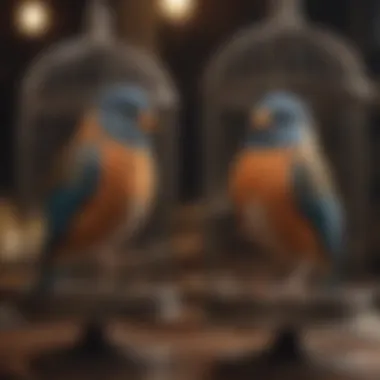
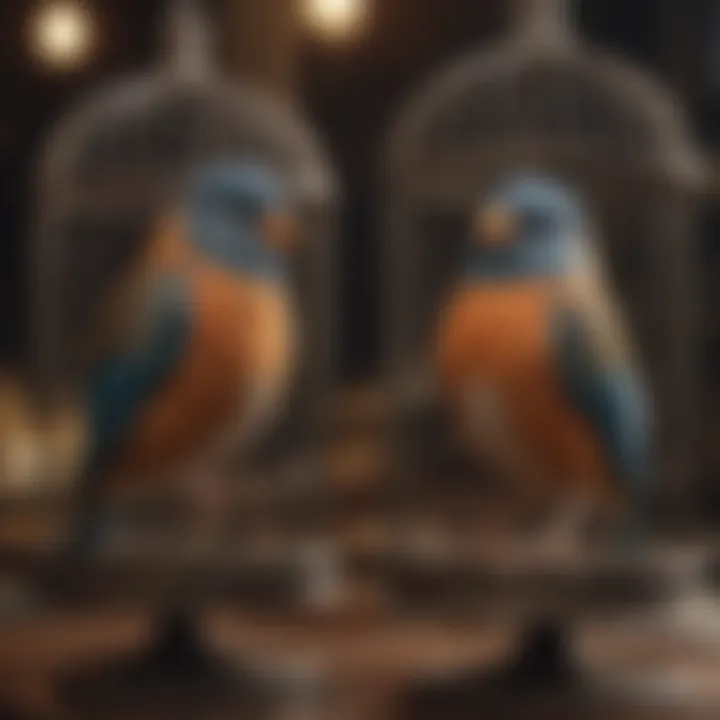
Intro
In the world of avian care, the right environment can make all the difference for our feathery friends. Dual bird cages have emerged as a fascinating solution that marries the needs of different bird species while providing ample space for movement and interaction. This guide seeks to illuminate the many intricacies involved in selecting, setting up, and maintaining these special habitats. Beyond mere aesthetics, understanding the significance of a well-planned living space for birds can enhance not only their quality of life but also the bond shared between the owner and their companions.
As we take this journey, we will explore various aspects that are pivotal in elevating both the birds' living conditions and the owner's experience. Delving into care tips, behavioral insights, nutrition needs, health and wellness considerations, and enriching activities, this comprehensive resource promises to be an essential companion for both novice and experienced avian enthusiasts alike.
Care Tips
Caring for birds housed in dual cages involves routines and practices that ensure their well-being. These routines cover various aspects, from daily care to adapting to seasonal changes.
Daily Care Routines
Each day should begin with checking on your birds, observing their demeanor and activity level. This not only establishes a routine but also helps to catch any early signs of distress or illness. Ensure fresh food and water are available. It's a good idea to rotate available resources to keep the environment stimulating. For instance, placing different toys or perches each day can make a significant impact in reducing boredom.
Cage Setup and Maintenance
Setting up the cage smartly is crucial. Make sure there’s enough space so the birds don’t feel cramped. Creating different levels with perches of varied heights will encourage movements and exercise. Avoid overcrowding with too many toys. The ideal setup will accommodate the social nature of many species while allowing for individualized retreats.
Maintaining the space also calls for regular checks on the integrity of perches and toys, replacing anything that seems worn out or broken to avoid injuries.
Hygiene and Cleaning Practices
Cleaning the cage should be part of your regular care routine. Aim for a thorough clean at least once a week. Use a bird-safe cleaner or a simple mixture of vinegar and water. Ensure food and water dishes are clean and changed daily. Regularly sanitizing provides a healthier environment, reducing the risk of disease.
Seasonal Care Adjustments
Birds can be sensitive to temperature changes. During winter months, consider moving the cage away from drafts. In summer, providing shade will help in keeping them cool. Be vigilant with their nutrition as well since dietary needs can shift with the seasons. Ensuring a balance of fresh fruits and vegetables throughout the year will support their overall health.
Behavioral Insights
To nurture a parasocial relationship with your avian companions, understanding their behaviors is key. Birds communicate through body language, vocalizations, and other non-verbal signals.
Understanding Bird Body Language
Recognizing signs of happiness or distress can aid in enhancing their environment. A relaxed bird will preen regularly, while a puffed-up bird may be feeling threatened or unwell. Observing these cues will foster a trusting relationship between owner and bird.
Common Behavioral Issues and Solutions
Behavioral issues might arise in dual setups due to competition for resources or social dynamics.
- Aggression: If birds are squabbling, assess their social structure, possibly separating them temporarily.
- Boredom: Engaging them with toys designed for stimulation can alleviate this issue.
Positive Reinforcement Techniques
Rewarding desired behavior with treats or affection can significantly improve training outcomes. Training doesn’t only apply to physical tricks but also to easing them into a cooperative space.
Social Interaction Needs
Understanding their social requirements is paramount. Birds are naturally social creatures. Interactions between different species can be rich but also require careful monitoring to ensure compatibility.
"The key to a happy bird is understanding its nature and providing an environment that caters to its needs."
Nutrition Guides
Feeding your feathered friends a balanced diet ensures their vitality and longevity.
Essential Diet Components
Different species have different dietary needs. Generally, a mix of pellets, seeds, and fresh fruits and vegetables form a balanced diet. Consult experts or dedicated literature for details specific to each type of bird.
Safe and Toxic Foods
It's essential to be aware of what’s safe for birds. For instance, apples are a great treat, while avocado can be toxic. Having a reference guide handy is a smart move.
Supplements and Treats
Sometimes, an extra boost is needed. Vitamins specific to your bird’s type can enhance their diet. Treats should be given sparingly and should always align with your bird’s nutritional requirements.
Feeding Strategies for Different Species
Adapting feeding strategies based on the species can lead to more effective feeding practices. For example, parakeets might thrive on a seed-based diet complemented by greens, while parrots require a wider variety of fruits and vegetables.
Wellness and Health
Monitoring a bird's health goes beyond observing their physical appearance.
Routine Health Checkups
Consider developing a relationship with an avian vet. Regular checkups can preemptively catch any illnesses or emerging health issues.
Identifying Symptoms of Illness
Becoming familiar with your bird's normal behavioral patterns will help you notice when something is off. Seek veterinary attention at the first signs of lethargy, changes in eating habits, or unusual droppings.
Preventative Care and Vaccinations
Staying informed about necessary vaccinations and preventive practices is crucial. Consult professionals for a schedule tailored to your bird's needs.
Mental and Emotional Well-being
Both mental and emotional health play substantial roles in avian care. Providing various stimuli and interactions improves their mental outlook and yields happier pets.
Enriching Activities
Engaging birds through play and interaction is a critical part of their overall care.
Toys and Playtime Ideas
Investing in a variety of toys that encourage physical activity and problem-solving is beneficial. Avoid those with small parts that can be ingested. Rotate these regularly to keep things fresh and engaging.
Training and Tricks
Engaging birds with simple tricks can be mutually beneficial. It strengthens the relationship while providing mental stimulation.
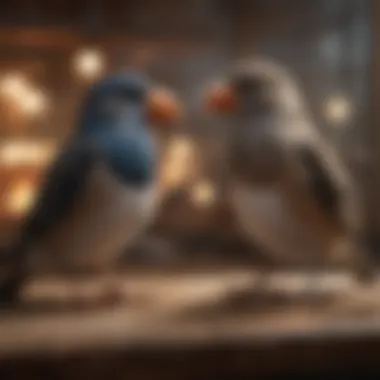
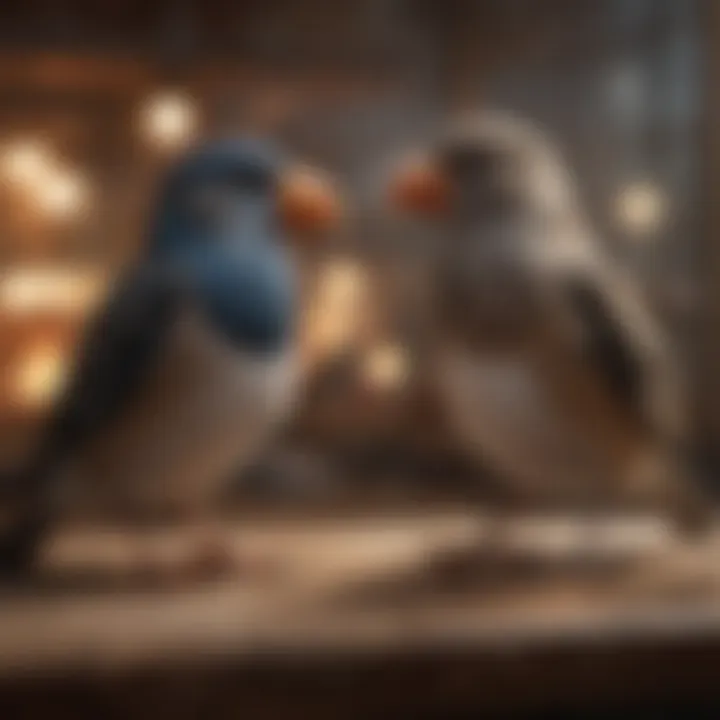
Outdoor Activities and Interaction
If possible, consider letting your birds experience the outdoors. Using a safe aviary or supervised outings in a cage can give them a taste of natural environments.
DIY Projects for Mental Stimulation
Creating homemade toys from safe materials can add a personal touch and promote engagement. Items like cardboard or untreated wood are excellent for crafting playful distractions.
By synthesizing thoughtful practices in care, nutrition, wellness, and enrichment, this guide aims to present a holistic approach to managing dual bird cages. The benefits of dual bird cages not only manifest in well-adjusted birds but also in the enriched lives of their owners.
Understanding Dual Bird Cages
The concept of dual bird cages is crucial for anyone with a love for feathered companions. These specially designed enclosures serve a significant purpose beyond mere housing. They offer an enhanced living environment that prioritizes the well-being of birds while fostering an emotional bond between the pet and the owner. Understanding dual bird cages means diving into not just their structure but also their multifaceted benefits, tailored designs, and the specific needs of various avian species.
Definition and Purpose
At their core, dual bird cages refer to enclosures that accommodate two birds, allowing for separation yet providing a shared living space when desired. These cages can vary in structure, but they typically feature interconnected compartments for different birds or splittable sections. The main goal of such a design is to facilitate social interactions while also offering the necessary space and privacy that certain bird species might require.
Importantly, this design supports companionship among birds while also recognizing their individual territories. It allows for a setup where birds can socialize—chirping, playing, or even preening each other—while also enjoying the option to retreat when they need their own space. Hence, dual bird cages not only protect birds from the risk of conflict but also encourage them to engage in their natural behaviors.
Benefits of Dual Housing
The advantages of embracing dual housing for birds are numerous and compelling:
- Socialization: Birds are social creatures. Having a companion can reduce loneliness, leading to a happier and often healthier life.
- Behavioral Enrichment: Being housed with another bird can stimulate natural behaviors that may not manifest when kept alone.
- Reduced Stress: When properly managed, dual housing can lessen the chances of stress-related issues that solitary birds may face.
- Increased Interaction for Owners: Owners have the opportunity to observe and learn about social dynamics, which can provide deeper insights into their pet's behavior.
- Space Efficiency: Dual cages tend to occupy less space than each bird having a separate cage, making them ideal for those with limited space in their homes.
Despite the benefits, responsible ownership is important, as compatibility between bird species and individual temperaments must be assessed to avoid conflicts.
Popular Species that Benefit
Not all bird species thrive in dual housing, so it's essential to consider which ones do. Here are popular birds that often benefit from sharing their space:
- Budgerigars (Budgies): These chatty little birds enjoy company and adapt well to having a cage mate.
- Lovebirds: Known for their affectionate nature, lovebirds can create strong bonds and benefit from dual housing.
- Cockatiels: Social and interactive, cockatiels thrive when they have another bird around to chirp and play with.
- Parakeets: Similar to budgies, they have a playful disposition, making them happy in a dual environment.
Having the right birds together in a dual cage can unleash a world of adventures and companionship, enriching their lives and yours.
Knowing the benefits and suitable species can help avian enthusiasts make informed decisions regarding dual bird cages, ensuring a fulfilling experience for both pets and their owners. The next step involves exploring various designs and types to find the perfect fit.
Types of Dual Bird Cages
Understanding the different types of dual bird cages is crucial for avian enthusiasts aiming to create an optimal environment for their feathered friends. These cages not only accommodate the social needs of birds but also improve overall well-being by offering unique living arrangements. Selecting the right cage involves considering various elements, including space constraints, bird species usage, and the intended purpose of the cage itself. Here’s a closer look at three main types of dual bird cages and how they cater to various needs.
Split Design Cages
Split design cages are a popular choice among bird owners who want to house multiple birds while maintaining some degree of separation. As the name suggests, these cages come equipped with dividers that can easily partition the space into two sections. This design allows birds that may not get along to still live in close proximity, minimizing stress.
When selecting a split design cage, consider the species being housed. For instance, larger parakeets often need more room compared to smaller finches. It's vital to ensure that each side is spacious enough to support perches and toys, as overcrowding can lead to behavioral issues.
"The best environment fosters comfort, safety, and interaction. A split design cage makes it easy to promote these attributes while keeping things harmonious."
Stackable Cages
Stackable cages are an ingenious solution for those with limited space. This type features two or more cages that can be stacked vertically, optimizing the use of floor space some like to call the ‘real estate’ of their living area. They are especially handy for breeders, as multiple species can be accommodated without the hassle of needing a sprawling setup.
One significant consideration with stackable cages is ventilation. Proper airflow is critical to avoid respiratory issues, particularly in multi-cage setups. Bird owners must ensure that the cages are not too cramped and that birds are not placed too closely together, which can result in stress or aggression.
Convertible Models
Convertible models represent the ultimate flexibility for bird enthusiasts. These cages can be transformed from a single large enclosure into separate areas as needed, making them ideal for owners who may want to introduce new birds over time. With a convertible model, you can seamlessly shift from a single shared living space to distinct sections.
These models can be especially beneficial for those who enjoy fostering or rehabilitating birds. The adaptability offered allows bird owners to manage the introduction of new companions gradually. Make sure to examine each feature closely, ensuring that the locking mechanisms and dividers are sturdy to guarantee the safety of the birds.
In summary, understanding these types of dual bird cages can empower bird owners to create a tailored sanctuary that meets the specific needs of their feathered companions. It’s not just about housing birds; it's about enhancing their quality of life.
Choosing the Right Dual Cage
Selecting the right dual cage is more than just picking one that looks good in your living room. It’s about ensuring the safety and comfort of your feathered companions while providing a suitable environment to thrive. This section delves into crucial considerations, from assessing available space to evaluating the specifics of material used in the cage construction. An informed choice can prevent future headaches and promote well-being for your birds.
Assessing Available Space
Before making any decisions about a dual bird cage, it’s of utmost importance to evaluate the space at your disposal. Not all homes are created equal; thus, knowing the dimensions of the area where you plan to place the cage is key. Look beyond the immediate floor space; consider ceiling height and nearby furniture that may limit your options.
- Measure Your Space: Use a tape measure to mark down the maximum dimensions. Ensure you allow for some elbow room, as cramped spaces can make even the happiest birds feel a bit claustrophobic.
- Access: The cage should be easy to reach. Not just for cleaning, but also to ensure you can engage easily with your birds. For example, if it’s a tall cage, check if you can safely reach the top for cleaning or to place perches without resulting in an awkward stretch.
Finding a perfect balance can lead to creating a comfortable habitat for your birds.
Considering Bird Species and Size
When selecting a dual cage, it’s fundamental to match the cage type with the species of the birds. Different species have varying needs for space and interaction. For some, size is a matter of health, while others might see temperament influenced by spaciousness.
- Small Birds (Canaries, Finches): Generally, smaller birds can be housed in more compact cages. However, they still need vertical space to fly and explore. A cage with added height can provide them an avenue to climb and play.
- Medium to Large Birds (Cockatiels, Parrots): For these species, size can’t be understated. They are more active and need ample space to flap their wings without hitting the sides. The width of the cage also matters, as some enjoy side-to-side movement.
Also, consider the social dynamics; some birds are more solitary while others thrive in groups. Knowing these traits is essential for choosing an ideal setup.
Evaluating Cage Material and Construction
The materials that make up a dual bird cage aren't just a matter of aesthetics; they must also support safety and longevity. Pay attention to specifics as these can affect your pets' overall health.
- Non-Toxic Materials: Make sure any cage you consider is made of safe materials. Some metals can be harmful to birds if they chew on them. Stainless steel is often a safe bet for its durability and resistance to corrosion.
- Bar Spacing: This is crucial for the safety of your birds. Bar spacing that’s too wide could allow smaller birds to escape or, worse, get stuck. A good rule of thumb is to choose spacing that prevents heads from slipping through but allows good visibility.
- Sturdy Construction: The cage must stand the test of time. Look for cages with solid latches and no sharp edges. The base should also be stable enough to prevent tipping, especially if you’re engaging in bonding activities inside.
In short, the right cage material contributes not just to the aesthetic appeal but significantly impacts your birds’ well-being.
"A well-thought-out environment can make the difference between just surviving and truly thriving."
Taking the time for thoughtful selection ultimately leads to a happier home for both you and your birds. Signing off on a dual cage means signing on to a commitment of care and observation, ensuring their lifestyle meets their natural instincts.
Setting Up Your Dual Cage
Setting up your dual bird cage is more than just finding a spot to plop it down. It's about creating a sanctuary for your feathered friends, a space where they can thrive, explore, and engage in their natural behaviors. The effectiveness of a dual bird cage lies heavily on how well it’s arranged, as this will ultimately influence the wellbeing of the birds and their environment.
Selecting the Right Location
Choosing the right location for your dual cage is crucial. It should be positioned where your birds can observe the activity of the household, but also maintain their safety and peace. Ideally, place the cage in a well-lit area that doesn't receive direct sunlight for extended periods. Natural light is great, but too much sun can overheat your birds.
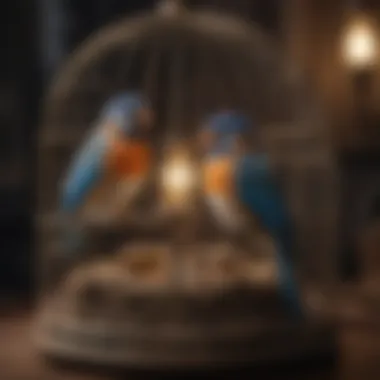
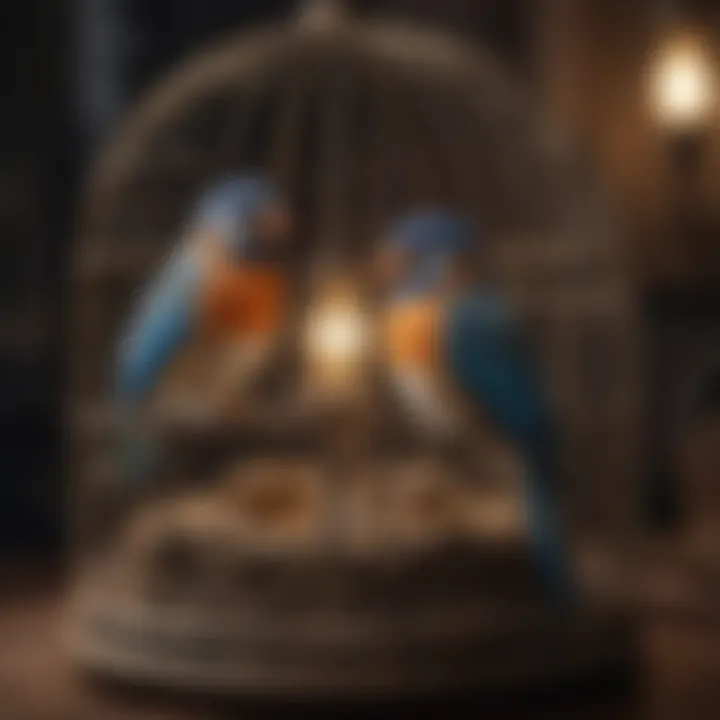
- Avoid Drafty Areas: Ensure the cage isn’t set up near windows or doors that might create drafts.
- Height Matters: Birds often feel more secure when they are slightly elevated. So, a stand on a table or a dedicated birdcage stand may work wonders.
“The right location makes a world of difference. Give them a space to watch, but not be overwhelmed.”
- Close to Family Activity: Birds are social creatures. Positioning their cage near where family conversations happen can reduce feelings of isolation.
Arranging Perches and Accessories
Once the location is sorted, it’s time to focus on how the inside of the cage is set up. Perches are not just functional; they can promote natural behaviors. A variety of perches made from different materials—like natural wood, rope, and platforms—will cater to their need to climb and perch comfortably.
- Vary Heights and Thickness: Different heights encourage exercise, while varying thickness mimics natural conditions. Birds love to grip, so providing perches that are slightly thicker helps maintain healthy feet.
- Add Functional Accessories: Consider including swings and ladders for more dynamic interaction. This can also break the monotony of their day-to-day life inside the cage.
- Utilize Vertical Space: Since many birds are keen climbers, make use of the vertical space in the cage by arranging the perches at various levels.
Providing Opportunities for Foraging
Birds have a natural instinct to forage. Implementing foraging opportunities within the dual cage setup can greatly enhance their mental stimulation and overall happiness. Simply adding foraging toys or scattered treats can invite exploration and interaction.
- Foraging Toys: Consider toys that require birds to work for their food, such as puzzle feeders or treat dispensers. These not only challenge them but also keep them engaged for longer periods.
- Scattering Seed or Treats: Dispersing food across the cage floor can tempt your birds to explore rather than just stay perched, thus mimicking natural behavior.
- Mix It Up: Changing up the foraging arrangements regularly prevents boredom, ensuring that they feel challenged and engaged.
In essence, a well-thought-out setup not only benefits the bird’s environment but also fosters a deeper bond between you and your avian companions. Attention to detail in these areas influences how satisfied your birds become in their new home.
Maintaining Dual Bird Cages
Maintaining dual bird cages is a vital aspect of deriving the most benefits from your avian companions' living arrangements. The health, happiness, and overall well-being of your birds can significantly hinge on how diligent you are in maintaining their habitat. Proper upkeep not only fosters a clean and safe environment but also influences the social dynamics among the birds and enhances their overall quality of life. Regular maintenance can prevent the buildup of harmful bacteria, reduce stress, and keep your birds engaged and content.
Cleaning and Sanitization Protocols
Cleaning your dual bird cage isn’t merely a chore; it's an investment in your feathered friends' health. Implementing a cleaning schedule is crucial. Birds, by their very nature, can be messy creatures, often scattering food and droppings throughout their habitat. Here’s a straightforward cleaning routine you might follow:
- Daily Tasks:
- Weekly Deep Clean:
- Remove uneaten food and debris.
- Change the water to ensure it remains fresh.
- Remove your birds and clean each section of the cage with a suitable, bird-safe cleaner. Most people go for vinegar or a mild dish soap. Avoid harsh chemicals.
- Sanitizing perches, toys, and feeding dishes is important too. Submerging them in a warm soapy solution and rinsing thoroughly can do wonders.
Remember: Regular cleaning helps reduce the risk of respiratory diseases and infections. Take care of the cage, and the cage will take care of your birds.
Regular Health Checks for Your Birds
Just like people, birds require regular health checks to catch any potential issues before they become serious. A dual cage often accommodates more than one bird, making it all the more important to monitor each one's health effectively. Regular health checks can help you identify subtle changes in behavior or health signs, which can often signal deeper issues. Here are some steps you could take:
- Physical Health Assessments:
- Behavioral Observations:
- Veterinary Visits:
- Look for changes in weight, feathers, and droppings. Track their eating habits too, as a significant decrease could be a red flag.
- Keep an eye on their social interactions. Is one bird becoming distant or aggressive? Such behavior could indicate stress or conflict.
- Schedule regular check-ups with an avian vet, particularly if your birds are of a species prone to health issues.
Monitoring Environmental Conditions
The environment where your birds live can be a game-changer in their well-being. Dual bird cages should be positioned thoughtfully, allowing you to monitor temperature, humidity, and lighting conditions. Adverse environmental factors can make your birds less comfortable and can lead to health problems.
- Temperature Control:
- Humidity Levels:
- Lighting Considerations:
- Ensure that the cage is placed in a location where it's not exposed to direct sunlight or drafts. Birds thrive in a stable temperature between 65°F and 80°F (18°C to 27°C).
- Dry air can affect feather quality and lead to respiratory issues. A humidity level of around 40% is generally favorable for most pet birds. You can use a hygrometer to keep track and add a humidifier if needed.
- Natural light is important. However, if sunlight isn't adequate, consider using full-spectrum lighting to replicate natural conditions.
By ensuring that your dual bird cages are well maintained, you not only contribute to your birds’ physical health but also create a harmonious living environment. This attention serves to nurture their social behaviors and psychological well-being, essential elements for fostering a happy flock.
Understanding Bird Interactions
In the context of dual bird cages, understanding bird interactions is paramount. Birds are inherently social creatures, and their interactions can significantly impact their overall well-being. In a dual cage setup, the way birds engage with each other can foster healthy behaviors or, contrarily, lead to conflicts. This section aims to unravel the complexities of these interactions, explore their benefits, and consider the factors that influence them, making it an essential aspect for any avian enthusiast.
Social Dynamics in Shared Spaces
When two or more birds share a cage, their social dynamics become fascinating to observe. Different species have varied social structures, and their interactions can be playful or territorial. For example, budgies often engage in friendly preening, indicating a bond, whereas cockatiels might display more assertive behaviors if they feel crowded.
It's crucial to create an environment that supports positive interactions, minimizing stress and fostering companionship. Consider the following tips to enhance social dynamics in shared spaces:
- Introduce slowly: New friends should be introduced gradually. This helps to prevent territorial disputes.
- Watch for signs: Observing body language is important. Look for signs of aggression, like fluffed feathers or heavy beaks.
- Provide equal space: Make sure that both birds have their own perches and feeding stations, which reduces competition and encourages harmony.
"Social interactions can define a bird's experience. It’s like a dance—sometimes synchronized, at other times, it can clash."
Addressing Behavioral Challenges
Challenges can arise when birds live together. They may show signs of aggression or engage in stressful behaviors if they feel threatened or neglected. Addressing these challenges early is crucial for maintaining a peaceful aviary.
Some common behavioral challenges include:
- Pecking order disputes: In many species, birds establish a rank. When one bird feels its status is threatened, conflicts arise.
- Fearful reactions: If one bird is significantly more timid, it might be bullied or ignored.
- Overbonding with owner: Sometimes, a bird develops a strong attachment to its human caregiver, leading to jealousy or aggression towards a roommate bird.
It’s beneficial to employ a range of strategies to alleviate these issues. Utilizing separate spaces for feeding, providing ample perches, and ensuring regular interaction with both birds can help. Calm and tentative introductions coupled with patience are key to resolving these challenges, leading to a more harmonious environment.
Facilitating Bonding Exercises
Bonding exercises can enhance relationships between birds. These activities not only encourage companionship but also help reduce behavioral problems. Simple exercises can be employed to foster links, making the shared living space enjoyable.
Here are some effective bonding exercises to consider:
- Shared play moments: Use toys that multiple birds can engage with. Swinging bridges or ladders can be excellent tools for teamwork.
- Dining together: Setting up communal feeding helps birds develop a shared experience, reducing feelings of competition.
- Supervised fly times: Allowing birds to explore outside their cage under supervision promotes socialization. They’ll feel more at ease in each other’s presence in a neutral setting.
Using these techniques can cultivate a friendly atmosphere and create a sense of community among your feathered friends.
In summary, understanding bird interactions is not merely about observing; it's about actively engaging in their social needs. Recognizing the dynamics, addressing potential challenges, and facilitating bonding can make a significant difference in the lives of both birds and their caretakers.
Enrichment Activities for Birds
Creating a rich and engaging environment for birds is vital for their well-being. Enrichment activities not only keep birds entertained but also stimulate their minds, promoting physical and mental health. Birds can easily become bored, leading to unhealthy behaviors such as feather plucking or excessive squawking. Incorporating diverse enrichment activities into their daily routine is key for any avian enthusiast.
Interactive Toys and Games

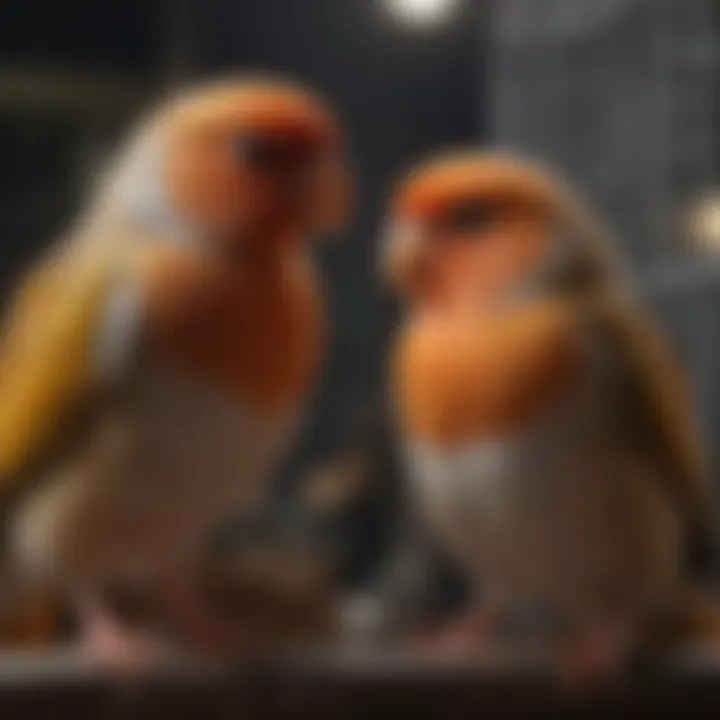
When it comes to bird playtime, interactive toys are a game-changer. Toys that require problem-solving or encourage movement can keep birds engaged for hours. Toys like puzzles, foraging devices, and hanging swings challenge birds’ natural instincts and promote activity.
Some popular options include:
- Foraging Toys: These toys hide treats within compartments, encouraging birds to work for their food, which mirrors their foraging behavior in the wild.
- Puzzle Feeders: These challenge birds to unlock mechanisms to access food, plus they're a fun way to combine eating with entertainment.
- Movement Toys: Swings and ladders not only provide physical exercise but also an outlet for climbing, which many birds adore.
"Interactive play keeps your feathered friends sharp and happy!"
Exploring Nutritional Enrichment
Birds’ diets can benefit from more than just the usual seeds and pellets. Nutritional enrichment involves providing varied diets that include fruits, vegetables, and grains, ensuring they receive the vitamins and minerals essential for their health.
Consider incorporating:
- Fresh Fruits and Vegetables: Foods like carrots, apples, and leafy greens can be offered daily to stimulate taste buds and provide nourishment.
- Cooked Grains: Brown rice, quinoa, or barley can be included in their meals, adding texture and variety.
- Sprouts and Seeds: Freshly sprouted seeds are a lively addition, packed with nutrients and flavor.
Feeding time can also be transformed into a fun activity. Scatter food around the cage or use feeding platforms to create a 'foraging fun' experience.
Creating a Stimulating Environment
Finally, a stimulating environment is crucial for avian happiness. This can be achieved through careful cage design and arrangement, ensuring birds have the right balance of exploration and relaxation.
Consider these factors:
- Variety of Perches: Use perches of different sizes and materials to encourage climbing and provide exercise.
- Natural Elements: Incorporating branches, plants, or safe chewing materials can imitate their natural habitats and offer sensory experiences.
- Visual Stimulation: Position colorful items or reflective surfaces strategically to catch birds’ eyes, satisfying their curiosity.
In essence, making simple changes in their habitat can lead to significant improvements in their behavior and overall wellness. Birds are incredibly intelligent creatures; stimulating their environment helps prevent boredom and encourages natural behaviors.
By thoughtfully designing interactions through toys, food, and their living spaces, bird owners can enhance the quality of their pets' lives and nurture the bonds they share.
Handling Common Issues
In the realm of avian companionship, handling common issues is paramount. Birds, much like humans, have their own set of quirks and challenges. Their emotional and physical well-being can deeply impact their ability to adapt and thrive in a dual cage environment. Addressing these issues head-on not only enhances the quality of life for these feathered friends but also strengthens the bond between the bird and its owner.
Addressing Aggressive Behavior
Aggression in birds can spring from a multitude of sources such as territorial instincts, fear, or even hormonal fluctuations. When things go south in a shared living space, it’s crucial to look into the signs of aggression, which might include loud squawking, biting, or even flapping defensively when approached.
One effective strategy involves giving a bird more personal space. Perhaps creating a separate area within the dual cage for a particular bird can alleviate tension. Alternatively, spending quality one-on-one time with each bird can help reduce feelings of jealousy or competition. Observe your birds closely, and aim to recognize their body language.
Here are a few quick tips to tackle aggression:
- Individual Attention: Spend time with each bird separately to form a bond and alleviate possessiveness.
- Safe Spaces: Ensure that each bird has a safe space to retreat when feeling threatened.
- Positive Reinforcement: Reward good behavior with treats or praise to reinforce non-aggressive interactions.
Dealing with Stress or Anxiety
Like any pet, birds can suffer from stress or anxiety, which can manifest in different ways such as feather plucking, excessive vocalization, or refusal to eat. Sudden changes in their environment, like the introduction of new birds or changes in the household, can contribute to these feelings.
Creating a calm, consistent environment goes a long way in reducing stress. Regular routines help birds feel more secure. For some, soft music or gentle background noise can soothe their nerves. Additionally, ensure there are plenty of hiding spots and places to perch to provide comfort.
To ease stress, consider these strategies:
- Routine Establishment: Stick to a daily routine for feeding, cleaning, and social interactions.
- Environmental Enrichment: Provide toys, perches, and foraging opportunities to keep their environment stimulating.
- Monitor and Adjust: Pay attention to their preferences and make adjustments to their cages as necessary.
Recognizing Signs of Illness
Diligently observing your bird’s behavior and overall appearance can be the key to catching medical issues before they escalate. Common signs of illness may include changes in droppings, lethargy, or a lack of interest in food. Quick recognition can be the difference between a swift treatment and a long-term health issue.
Regular health checks such as monitoring weight and examining feathers for abnormalities should be part of your routine. If you notice anything out of the ordinary, reach out to a vet familiar with avian care without delay. Feathered friends often hide their ailments well; hence being vigilant is paramount.
Here are essential signs to keep an eye on:
- Changes in Appetite: A sudden drop in food intake or water consumption can indicate health troubles.
- Behavioral Changes: Increased isolation, reduced movement, or unusual vocalizations may signal stress or illness.
- Physical Appearance: Watch for ruffled feathers, swelling, or any discharge from the beak or eyes.
"Early intervention can save our feathered companions from severe health issues, allowing for more quality time together."
By addressing aggressive behavior, managing stress, and recognizing signs of illness, you ensure both you and your birds can flourish in a harmonious environment. In the next sections, we will continue to explore the beauty of avian care, focusing on creating an enriching and loving space for your feathered family members.
The Importance of Regular Interaction
Birds are social creatures by nature. Their interactions with both their kind and humans play a crucial role in their overall well-being. As a pet owner, acknowledging and acting on this need for regular interaction is vital. The right amount of engagement can lead to happier, healthier birds. When we talk about the importance of interaction, we are not just considering playtime. It extends beyond games to involve communication, bonding, and understanding the unique personality traits of each bird in your care.
Understanding Social Needs of Birds
Different species of birds have varying social requirements. For instance, parrots are known to thrive on interaction and communing with their owners, while finches may be more independent but still appreciate the company. Understanding these social dynamics is essential for fostering a suitable environment. Birds are genetically wired for social connection; an isolated parakeet might become withdrawn or even develop behavioral issues. Just as humans feel loneliness, birds can express similar distress when isolated for extended periods.
To better grasp these social needs, note the following points:
- Species-Specific Traits: Know how your bird’s species impacts its social needs. Species like cockatoos crave companionship intensely.
- Behavioral Observations: Pay attention to your bird’s body language. Are they vocalizing often? This could signal a need for attention or interaction.
- Play and Exploration: Birds learn through interaction in playful situations. It aids in developing skills they would naturally gain in the wild.
Benefits of Daily Engagement
Engaging with your bird daily delivers multiple advantages that resonate well beyond a mere routine. For one, consistent interaction strengthens the human-animal bond, creating a sense of security for your feathered friend. A strong bond leads to more trust, making it easier for you to handle your bird when needed. In addition, daily engagement can provide mental stimulation through a variety of activities, from talking with your bird to teaching tricks. Here are several compelling benefits:
- Reduced Stress: Birds experiencing daily interaction often exhibit reduced stress levels. This interaction acts as an emotional buffer against anxiety.
- Behavioral Improvement: Engaging your bird can reduce negative behaviors like plucking feathers or excessive squawking.
- Enhanced Lifespan: A stimulating environment combined with regular interaction can lead to improved health and longevity.
"Engagement is the glue that holds the bird-owner relationship together."
Techniques for Meaningful Interaction
Now, it’s great to know the importance of regular interaction and its benefits, but how can you ensure that these interactions are meaningful? Here are a few techniques that can make a big difference in how you connect with your avian companions:
- Interactive Play: Use toys that require collaboration, such as puzzle feeders, to encourage engagement.
- Routine Voice Interactions: Birds often recognize voices; repeating phrases or songs can trigger their response, encouraging them to mimic or engage back.
- Training Sessions: Short, consistent training sessions using treats can turn learning into an enjoyable bonding experience.
- Naturalistic Approaches: Emulate natural behaviors like foraging or exploring. Hide food around the cage or provide materials, allowing your birds to engage their instincts.
Finale
Drawing from the detailed exploration of dual bird cages, it’s clear that the subject holds significant merit for avian enthusiasts, ranging from pet bird owners to seasoned breeders. The ultimate aim of setting up a dual cage is not merely to house birds but to enhance their overall well-being while fostering a strong bond between birds and their human caretakers. A well-chosen dual bird cage promotes an enriched living environment that caters to the varied social, emotional, and physical needs of different bird species.
Recap of Key Points
- Definition and Purpose: Dual bird cages serve a dual function—providing a cozy space for one or multiple birds while enabling some necessary social interactions among them. This keeps our feathered friends both happy and healthy.
- Benefits: The advantages of dual housing extend beyond mere space. Birds can enjoy companionship, which is vital for social species, while owners can keep an eye on their feathered pals’ behaviors more easily.
- Types of Cages: Various configurations like split design cages, stackable options, and convertible cages cater to specific needs. Each style offers unique benefits that suit different lifestyles.
- Maintenance and Interaction: Regular cleaning, health checks, and meaningful interactions are essential for maintaining a healthy environment for your birds, ensuring both their happiness and your peace of mind.
Final Thoughts on Dual Bird Cages
Caring for birds in a dual cage environment involves a deep commitment, understanding, and appreciation of their needs. It’s not just about providing food and water. The right setup can transform a standard living space into an avian sanctuary. As birds thrive on social dynamics, a dual cage can facilitate bonding, play, and even cooperative behaviors, enriching their lives significantly.
"The greatness of a nation and its moral progress can be judged by the way its animals are treated." - Mahatma Gandhi
Creating a space that respects and nurtures avian life not only enhances the lives of birds but also deepens our own connection with them.















